Battle of Liaoyang. Part of 2
After the retreat of the Russian troops to the Liaoyansky fortified area, the offensive outburst of the Japanese army was significantly weakened by weather conditions: heavy rains replaced the exhausting heat. The rains turned the area around Liaoyang into a sea of mud. On small and usually calm rivers powerful streams of water flowed. In addition, the Japanese needed to organize the rear, establish a new communication on Yingkou and prepare the newly captured section of the railway for their rolling stock. The armies of Oku and Nozu were located in the Heichen-Newzhuang area. Kuroki's army remained in the Yushulin-Thavuan position.
At this time, the Russian army continued to grow. At the beginning of August, the 17 Army Corps units under the Bilderling command had fully arrived. In mid-August, parts of the Dembovsky 5 Siberian Corps began to arrive. Behind him was expected the arrival of the 1-th army corps of Meiendorf.
However, the Japanese army was also replenished. The Japanese command has not yet exhausted the sources of trained replenishment. Without increasing the number of existing compounds, the Japanese staffed parts to the standard composition. At the same time, a well-developed espionage system supplied the Japanese command with fairly accurate data on the disposition and strength of the Russian Manchurian army, and the arriving recruits. Intelligence data greatly disturbed the Japanese. The time factor played against the Japanese empire. This forced the command to hurry with the start of a decisive offensive, which was supposed to lead to victory in the entire military campaign. The Japanese decided to attack, without waiting for the fall of Port Arthur and the end of the rainy season.
Japanese commander Oyama Iwao developed a plan that provided for a concentric offensive of the three armies. The 2 and 4 armies were to attack the Southern group, the 1 army to the Eastern group of Russian troops with access to the communications of the Russian army north of Liaoyang. The difficulty of the frontal attack against the southern group of the Manchurian army was that the success of the main forces required that the Kuroki 1 Army threatened the rear of the Zarubayev group, destroying the stability of the Russian defense. First, the Kuroki army had to go to the Tanghe River in order to move in the direction of the Liaoyan. The 2 and 4 armies were to continue to attack Liaoyang in the rail line. Their first task was to capture the Eisanjian position.
The Japanese command was not able to concentrate superior forces near Liaoyang. Therefore, Oyama did not set maximum tasks for the generals. Kuroki had to, “if it would be possible,” force Taijihe and enter Russian communications. Oka and Kuroki did not receive the task to close the flanks of their armies to the rear of the Russian troops. There was simply no power for that.
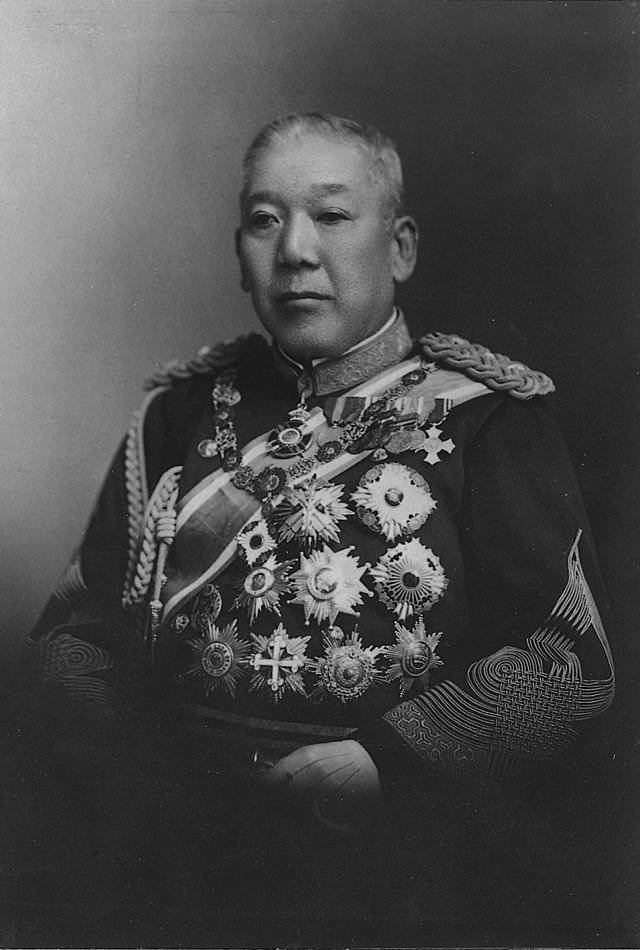
Japanese Commander Marshal Oyama Iwao (1842 — 1916)
At this time, the Russian command hesitated in choosing the final plan for further action. A long lull at the front did not induce Kuropatkin to attack, but only confirmed him in the opinion that it was necessary to take the battle in the positions held. At the same time, Kuropatkin did not forget to warn the commanders about the need to retreat to the advanced Liaoyang positions. Fighting at the distant approaches to Liaoyang should have been only demonstrative. The final decision of the commander in chief resulted in "stubborn resistance."
At the same time, Kuropatkin did not have any hopes for success in the upcoming battle. Already in early August, he began to develop a plan for the possible evacuation of Liaoyang. Stocks accumulate here ceased. In wars, much depends on the perception of the enemy, and perception on the work of intelligence services. The Russian commander-in-chief, General Kuropatkin, still believed that the Japanese army outnumbered his forces. He did not count on the rapid arrival of replenishment. Heavy downpours blurred the roads. Kuropatkin wrote: “We don’t have enough people to maintain the necessary superiority over each of the enemy’s groups, without opening ourselves in the direction of two more enemy unions.” The roads were damaged and could not quickly transfer heavy weapons and military materials.
Kuropatkin himself was in a depressed state of mind. For six months of the war, the commander in chief was unrecognizable. Failures made Kuropatkin old and gray. The general bore the brunt of defeat and irritation that swept the tops of the Russian Empire. They themselves led Russia to this position, and now they could not understand why a huge and powerful empire could not crush a small island nation.
Only now the top military-political leadership of the Russian Empire began to appreciate its Asian opponent. In a report to sovereign Nicholas II from 4 August 1904, Mr. Kuropatkin pointed out several advantages of the enemy: 1) Japanese armed forces in the Far East have a margin in the total number of troops; 2) the Japanese are more accustomed to the natural conditions and terrain; 3) Japanese soldiers are younger, carry less weight (with the Japanese armies there were whole “labor armies” of coolie porters), they have good mountain artillery and utility vehicles; 4) Japanese generals look better than Russian, Japanese generals are energetic and smart; 5), the troops are distinguished by a high fighting and patriotic spirit, they know what they are fighting for, unlike Russian soldiers, where "the characteristic patriotic burning is not felt."
This was a very important point. The Russian authorities did not manage to explain to the people, and therefore the Russian soldier, why it was necessary to shed blood in faraway China. On the contrary, most of the intellectual-democratic press did not bother with thoughts about the future of the empire, about the danger of war with Japan. The spirit of conviction devoured the Russian public. The Russian Empire waged a heavy war, there was a question about the future Russian presence on the shores of the Great (Pacific) Ocean, and the "heroes" of the press were murderers, terrorists, revolutionaries. The so-called best minds of Russia carried out destructive work against their own statehood, without even thinking about their own fate. The liberal intelligentsia was engaged in discrediting the “insane imperial plans” of tsarism, not thinking about the fate of the mobilized peasants, or about the future of their country, which the cruel imperialist predators dreamed of devouring. The fact that Britain and the United States set Japan on Russia and are waiting for the moment to break the Russian state into spheres of influence and colonies.
10 August (23) August 1904 The southern group of the Manchurian army as part of the 1, 2 and 4 of the Siberian corps occupied defenses on the so-called. Icelandic positions. Corps defended 15-kilometer area. Ahead were strong guards. The grouping consisted of 70 Thousands of Soldiers with 152 guns. The eastern group under the leadership of Bilderling occupied the 32-kilometer stretch of Liangasan-Anpilin and further to the Taijihe River. The group included the 3 Siberian and 10 Army Corps, a number of individual units. She numbered 55 thousand people 298 guns. On the protection of the flanks were involved 8 thousand people. The reserve included the 17 corps (it had been listed as a reserve of the Eastern detachment since the beginning of the battle), the Mishchenko detachment, and the reinforcements arrived. The reserves were located in Liaoyan and numbered about 28 thousand people. In addition, parts of the 5 Siberian Corps were planted in Mukden, consisting of about 30 thousand people and 48 guns. In total, by the beginning of the operation, the Russian army numbered about 160 thousand bayonets and sabers (excluding troops in Mukden) and about 600 guns. Russian troops were located on the front in 75 kilometers.
KNUK's 1 Army occupied the Yushulin-Tkhavuanskaya position, threatened the left flank of the Russian army, and consisted of 45 thousand bayonets and 130 guns. The backbone behind the right flank of the Kuroki army position was located at Siheyan’s Umeawa reserve brigade. On the left bank of Ukhodedza were the 2-I and 4-I armies of the Oku and Nozu. They numbered about 80 thousand people with 328 guns. The total number of Japanese troops reached 125 thousand people with 484 guns. At the same time, the forces of the Japanese armies increased during the whole battle due to the staying reinforcements. Thus, the Eastern group of the Manchurian army surpassed the KNurox 1 army, while the Southern group was inferior in numbers to the 2 and 4 armies.
However, with the Russian reserve in Liaoyang, the Russian army was stronger than the Japanese. The Japanese army accumulated troops more slowly than the Russian army. Daily came the train with reinforcements. The expectation of the rapid fall of Port Arthur, which attracted considerable forces of infantry and artillery, did not justify itself. Powerful 3-I army of Legs got stuck at the Port Arthur fortress. And the 8 division was in no hurry to move from Japan, the Japanese had not yet achieved final supremacy at sea. At the same time, the Japanese had an advantage in the advantageous positions of offensive groups. The location of the armies made it possible to conduct operations with a concentric attack from the south and east. Therefore, the Japanese command, taking into account the passively defensive tendencies of the Russian command, was not afraid to attack.
However, in the opinion of many of the then military specialists, the behavior of the Japanese strategically bordered on the adventure. With skillful and decisive leadership, the Russian army could split the Japanese front (between 4 and 2 armies in the south and 1 in the east, the distance was almost 40 kilometers), surround and completely defeat the enemy.
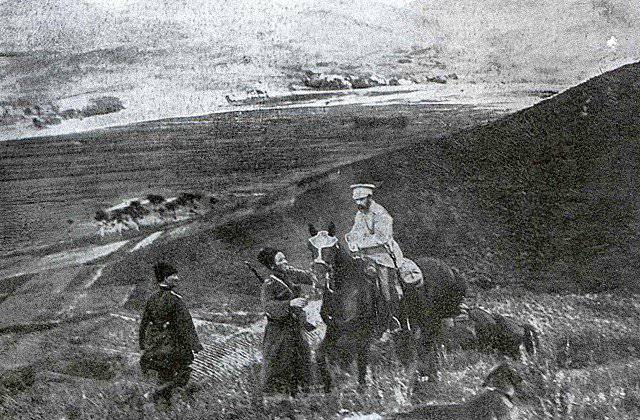
General Kuropatkin during the battle of Liaoyang
Liaoyang
Liaoyang City stood on the Tayzu River (Taijihe), which flows from the east. It was an ancient city, built by the Chinese fortifications. It was the second largest city of Manchuria, it was second only to Mukden in terms of population. The city walls, built of clay bricks, were high. The Taijiehe tributary - the Tang River (Tanghe) flowed from south to north and flowed into Taijihe at 15 kilometers east of Liaoyang. During the dry period, the rivers dried up and could impede the movement of troops. During the rainy season, they spilled heavily. The peak of the rainy season was in the middle of August and both rivers were overcrowded. But it didn't bother the Japanese, it was impossible to wait, and they decided to attack.
In the eastern part of the theater of operations, the terrain was difficult to reach, mountainous with lengths and mountains with steep slopes. As it moved west, the terrain to the south and north of the Taijihe River acquired the character of a plain, which was crossed by small groups of hills. The Russian troops controlled the railway, the Japanese had two communications - the old Mandarin road leading from the west coast to the depths of the continent and the road from the Korean Peninsula.
The Russian army had several lines of defense. The Icelandic stance closed the way to the armies of Oku and Nozu. The position was well fortified. From the east, its bypass was made difficult by mountainous terrain. The right flank was ensured by the proximity of the border of neutral China and the narrowness of the band where troops could move. The positions of the Eastern Group (Liandyasanskaya and Anpilina positions) had good approaches from the side of the enemy and could easily be captured. The shelling for artillery was bad, the enemy’s infantry could concealed close to the Russian positions. The Tangkhe River crossing the position made it difficult to communicate and maneuver along the front. Both positions of the Eastern detachment possessed only one route of departure to Liaoyang. All three positions formed an arc of about 75 km in length and represented the first line of defense of the Manchurian army. Their weakness was poor communication due to the rugged nature of the terrain. The enemy could find weaknesses in the Russian defense.
The Russian commander-in-chief, Kuropatkin, considered these positions “rearguard” and did not plan to defend them for long. The second line of defense was held on the so-called. "Advanced" position. Its length was in 22 km and it ran from the railroad to the Taiceyhe river. It also consisted of three positions: Meetunskoy, Zofantunskoy and Kavlitsunskoy. If Maetoun was well fired, then in the other two positions, due to rough terrain, there were many convenient approaches and dead zones from the enemy. This line of defense had no serious engineering structures. The work was limited to the construction of incomplete trenches, the clearing of the shelling zone at 300-600 steps, and the construction of a small number of artificial obstacles. In addition, on the reverse slopes of the slopes built gun trenches with the expectation of firing from closed positions. The “advanced” position could withstand the frontal attacks of the enemy, but with the appearance of Japanese troops on the right bank of the r. Taijihe stability of this line of defense collapsed.
The third line of defense was the main one. The Liaoyang position stretched for 14 km, had 8 forts of a temporary nature and 8 redoubts. The right flank began with Fort VIII near the village of Houjialins on the right bank of Taijihe. Then the line of defense stretched out in a semicircle south of Liaoyang, resting against the left flank in Taijihe near the village of Efa. In the intervals between forts and redoubts rifle trenches and artillery positions on 208 guns were prepared. The terrain was cleared by a position to improve the shelling, and there were artificial obstacles. The weakness of the position was the fact that it did not have the depth of the defensive orders, as a result of which the reserves were exposed to the danger of shelling, not directly participating in the battle. In addition, practically nothing was done to strengthen the region on the right bank of the Taijihe, east of Liaoyang. As a result, if the enemy appeared on the right bank of the river, the defense of the fortified area from this direction would not be ensured at all.
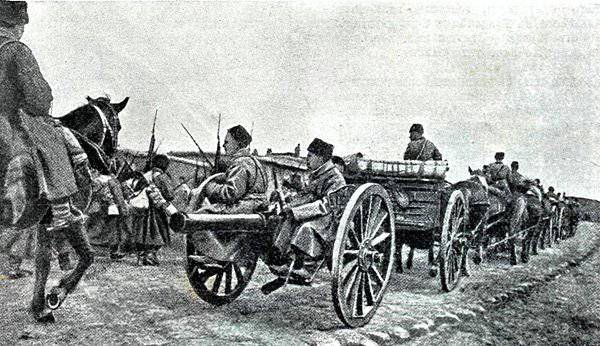
Russian artillery on the road to Liaoyang
The beginning of the battle. Eastern group withdrawal
11 August (24 August) 1904 d. 1-I Japanese army of General Kuroki began to move around the left flank of the Eastern group of the Russian army. Japanese troops were to capture Russian positions on the Tanghe River. The onset of the other Japanese armies was supposed to begin after the Kuroki army had achieved some success.
Kuroki decided to deliver the main attack on the Anpilina position defended by the 10 Army Corps. The 2 and 12 divisions were supposed to attack here. In order to mislead the Russian command, a part of the 1 Army imitated the start of a general offensive - the Hasegawa Guards Division was launched against the 3 of the Siberian Corps under the command of Ivanov. She had to tie the Russian troops at the front and draw reserves, threatening to cover the right flank.
On the night of August 24, Hasegawa's guardsmen from the Thavuan area went on the offensive. Guards Division threatened to reach the poorly protected right flank of the 3 Siberian Corps. The Japanese shot down the military escort of the Russian troops on the right flank and center, but the 3 of the Siberian Corps repulsed attacks on the main positions. Japanese troops began to dig in on new frontiers. The actions of the Japanese caused the Russian command the impression that the enemy was preparing for a decisive battle in this direction. In reality, this was a demonstration that distracted Russians from the direction of the main strike at the position of the 10 corps. Thus, Kuroki managed to mislead the Russian command. All attention was riveted on the right flank of the Eastern Group.
On August 25, the guards division continued its offensive and by the evening entered the Liandyasan-Tunxingpu line. On the same day, the 3 th Siberian Corps, fearing a detour, lengthened the right flank. Grekov’s squad joined the right wing. In addition, Kuropatkin isolated the 35 Infantry Division (from the 17 Corps) from the reserve to strengthen Ivanov's corps.
On the same day, the 12-i and 2-i divisions began to move. At night, the Japanese rejected the advanced units of the Russians occupying the mountain range east of Pego, and began to cover the left flank of the 10 corps. The pressure of the Japanese on the left flank of the 10 Corps and the commenced departure of the right wing of the corps due to the onset of the 2 Japanese division forced the Russian command in 16 on August 26 to clear the Anpilin positions. Russian troops retreated to the valley of the Tanghe River, leaving part of the artillery in the hands of the Japanese. The commander of the 10 Corps, Sluchevsky, requested reinforcements from the head of the Eastern Bilder Group, but did not receive it. The main reserves of the group were thrown on the right flank. The 3 division of the 17 corps remained in reserve, but it was saved. Not receiving reinforcements, Sluchevsky led the troops to the rear position. Kuropatkin found out about what happened late in the evening and ordered a counterattack using a reserve. However, at midnight, he canceled his previous order.
At the same time, the battle continued on the right flank. On the night of August 26, the Guards Division continued its offensive on the Kiminsa - Tunxinpu front. The Japanese delivered a fire strike with 60 guns. The Japanese artillery positions were located mainly to the east and south of the villages of Tagou and Tunxinpu. However, the Japanese artillerymen met a powerful rebuff of the Russian batteries. By 11 hours, the Japanese artillery was partially crushed, but the Japanese infantry continued to move.
Pushing aside the detachments of Druzhinin and Grekov, the Japanese guard moved in the direction of Pavshugo, encompassing the right flank of the Russian corps. However, this attack was repelled by the decisive actions of the 140 Zaraysk Regiment (from the 35 Infantry Division). The Zaraisk Regiment moved from Zofantun to the division's concentration area - to Kofyntsyn. The commander of the regiment, Colonel Yevgeny Martynov, having learned on the way about the appearance of the enemy from Pavshugou, on his own initiative (which was not enough for the Russian generals during this campaign), changed the direction of the regiment's movement. Coming out to Pavshugou, Martynov struck Tasigou, sweeping the left flank of General Assad's 1 Brigade. More to the right of the main forces of the regiment were the hunting team of the Zaraysky regiment and the squad of Vischinsky. Suddenly, the attacked Japanese Guard attempted to hold on, but was rejected. The Japanese tried to strike at the front of Katasy-Tasintun, but even here they were stopped by Russian artillery fire. After which the battle was interrupted by heavy rain. As a result, the Eastern Group retreated. On the morning of August 27, the Japanese launched an offensive, but did not meet the enemy.
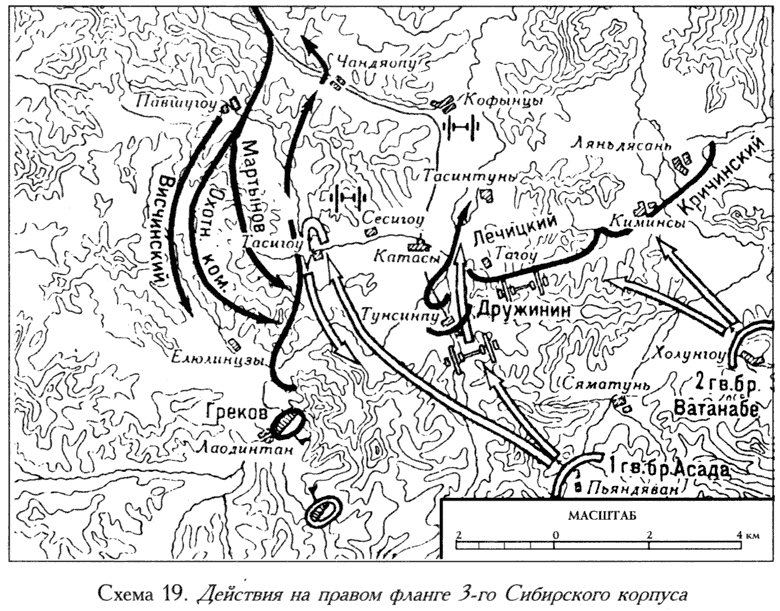
Source: N. Levitsky. Russian-Japanese War 1904-1905 M., 2003
South group
25 August, Japanese troops launched an offensive on the front of the Southern Group. 2-I army inflicted a frontal attack, and 4-I army had to bypass the Russian position from the east. Akiyama's cavalry brigade was supposed to try to cover the right flank of the southern group.
1-th Siberian Corps held positions on both sides of the railway. On its left flank, the 2 of the Siberian Corps was located; it occupied a position near the villages of Zhangtszyvo and Kusanzi. The gap between these corps was defended by a detachment of two regiments. In the rear of the 1 Corps, Syfanty had the 4 Siberian Corps. The left wing was covered by Trubetskoy, Tolmachyov and Posokhov's detachments, the right - by Gurko's cavalry.
10-I Japanese division and 10-I reserve brigade began movement at night. They forced the Tolmachyov and Trubetskoy detachments to retreat to Kusanze. Thus, the path to reach the left fang of the South Group was opened. At the same time, the rest of the divisions of the Japanese armies began to move and rejected the Russian advanced units. They retreated without providing serious resistance, not even trying to identify the strength and location of the enemy grouping.
Kuropatkin doubted for some time, but the data on the state of affairs at the front of the Eastern Group caused the final decision to withdraw the Manchurian army to the advanced Liaoyang positions. Russian troops under heavy rains retreated to new positions. The retreat passed without hindrance: the Japanese troops did not expect the enemy to retreat quickly and were preparing for a decisive assault on the Eisanjian position. In addition, heavy rain and fog hid the retreat of the Russian troops, and the weak military intelligence of the Japanese (the spy network was much better organized) did not give any data about the retreat.
By the morning of August 29, the Russian Manchurian army had moved to the second line of defense, which was located in 7-9 km from the city. The Russian army, led by the generals, who imagined the enemy’s power was doubled and constantly looked at the “rear” positions, failed to organize stubborn resistance and disrupt the enemy’s plans at the first stage of the battle. Although the actions of the 140 Zaraysk Regiment showed that the outcome of the battle could have been different if the Russian generals waged a war in the Suvorov style, were aggressive, strong-willed and initiative. The Russian troops lost about 4 thousand people these days, the Japanese less.
The Japanese won the first, very morally important victory. The plan of concentric coverage of the Russian troops by the combined efforts of the three Japanese armies has become more realistic. Japanese troops came close to the Liaoyang positions, and the convergence of the eastern and southern groups could lead to the encirclement of the Russian troops.
To be continued ...
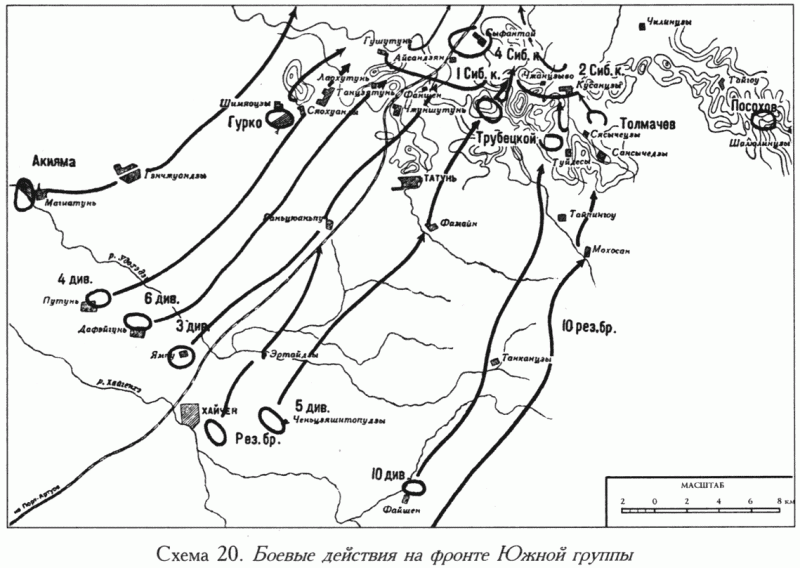
Information